 W
WThe 3-inch ordnance rifle, model 1861 was a wrought iron muzzle-loading rifled cannon that was adopted by the United States Army in 1861 and widely used in field artillery units during the American Civil War. It fired a 9.5 lb (4.3 kg) projectile to a distance of 1,830 yd (1,670 m) at an elevation of 5°. The 3-inch rifle was not as effective in firing canister shot as the heavier 12-pounder Napoleon, but it proved to be highly accurate at longer ranges when firing shell or shrapnel. There was only one reported case of a 3-inch ordnance rifle bursting in action. This was in stark contrast to the similarly-sized cast iron 10-pounder Parrott rifles which occasionally burst without warning, inflicting injury on the gun crews. The Confederate States of America lacked the technology to manufacture successful copies of the 3-inch ordnance rifle. However, the Confederate States Army respected the weapons and employed those captured from Federal forces.
 W
WThe 10-pounder Parrott rifle, Model 1861 was a cast iron muzzle-loading rifled cannon that was adopted by the United States Army in 1861 and often used in field artillery units during the American Civil War. Like other Parrott rifles, the gun breech was reinforced by a distinctive wrought iron reinforcing band. The gun fired a 9.5 lb (4.3 kg) projectile to a distance of 1,850 yd (1,692 m) at an elevation of 5°. The 10-pounder Parrott rifle was capable of firing shell, shrapnel shell, canister shot, or solid shot. Midway through the war, the Federal government discontinued the 2.9 in (74 mm) version in favor of a 3.0 in (76 mm) version. Despite the reinforcing band, the guns occasionally burst without warning, inflicting injury on the gun crews. The Confederate States of America manufactured a number of successful copies of the gun.
 W
WThe 12-pounder Whitworth rifle was a medium caliber field gun deployed during the mid-19th century. Designed by Joseph Whitworth, the gun was most notably used during the American Civil War. The gun was also used by the Imperial Brazilian Army in the War of the Triple Alliance.
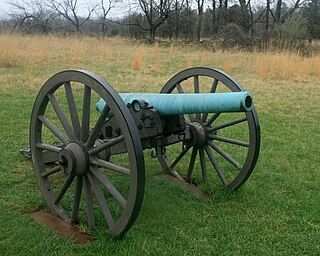 W
WThe 14-pounder James rifle or James rifled 6-pounder or 3.8-inch James rifle was a bronze muzzle-loading rifled cannon that was employed by the United States Army and the Confederate States Army during the American Civil War. It fired a 14 lb (6.4 kg) solid shot up to a distance of 1,530 yd (1,400 m) at 5° elevation. It could also fire canister shot and common shell. Shortly before the war broke out, the U.S. Army adopted a plan to convert M1841 6-pounder field guns from smoothbore to rifled artillery. Rifling the existing 6-pounders would both improve the gun's accuracy and increase the weight of the shell. There were two major types produced, both were bronze with a bore (caliber) of 3.8 in (97 mm) that would accommodate ammunition designed by Charles Tillinghast James. The first type looked exactly like an M1841 6-pounder field gun. The second type had a longer tube with a smooth exterior profile similar to a 3-inch Ordnance rifle. At first the rifles were quite accurate. However, it was discovered that the bronze rifling quickly wore out and accuracy declined. None of the rifles were manufactured after 1862, and many were withdrawn from service, though some artillery units employed the guns until the end of the war.
 W
WThe 20-pounder Parrott rifle, Model 1861 was a cast iron muzzle-loading rifled cannon that was adopted by the United States Army in 1861 and employed in field artillery units during the American Civil War. As with other Parrott rifles, the gun breech was reinforced by a distinctive wrought iron reinforcing band. The gun fired a 20 lb (9.1 kg) projectile to a distance of 1,900 yd (1,737 m) at an elevation of 5°. The 20-pounder Parrott rifle could fire shell, shrapnel shell, canister shot, and more rarely solid shot. In spite of the reinforcing band, the 20-pounder earned a dubious reputation for bursting without warning, killing or injuring gunners. The Confederate States of America also manufactured copies of the gun.
 W
WThe 70-pounder Whitworth naval gun was designed by Joseph Whitworth during the 1860s. It was a rifled muzzle loader and used his hexagonal, rifled-bore design.
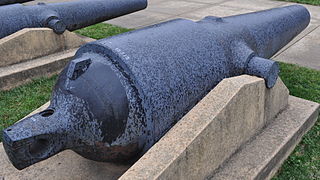 W
WThe Brooke rifle was a type of rifled, muzzle-loading naval and coast defense gun designed by John Mercer Brooke, an officer in the Confederate States Navy. They were produced by plants in Richmond, Virginia, and Selma, Alabama, between 1861 and 1865 during the American Civil War. They served afloat on Confederate ships and ashore in coast defense batteries operated by the Confederate States Army.
 W
WCanister shot is a kind of anti-personnel artillery ammunition. Canister shot has been used since the advent of gunpowder-firing artillery in Western armies. However, canister shot saw particularly frequent use on land and at sea in the various wars of the 18th and 19th century. Canister is still used today in modern artillery.
 W
WThe Canon obusier de 12, also known as the "Canon de l’Empereur", was a type of canon-obusier developed by France in 1853. Its performance and versatility allowed it to replace all the previous field guns, especially the Canon de 8 and the Canon de 12 as well as the two howitzers of the Valée system.
 W
WA carronade is a short, smoothbore, cast-iron cannon which was used by the Royal Navy. It was first produced by the Carron Company, an ironworks in Falkirk, Scotland, and was used from the mid-18th century to the mid-19th century. Its main function was to serve as a powerful, short-range, anti-ship and anti-crew weapon. The technology behind the carronade was greater dimensional precision, with the shot fitting more closely in the barrel thus transmitting more of the propellant charge's energy to the projectile, allowing a lighter gun using less gunpowder to be effective. Carronades were initially found to be very successful, but they eventually disappeared as naval artillery advanced, with the introduction of rifling and consequent change in the shape of the projectile, exploding shells replacing solid shot, and naval engagements being fought at longer ranges.
 W
WA Coehorn is a lightweight mortar originally designed by Dutch military engineer Menno van Coehoorn.
 W
WThe columbiad was a large-caliber, smoothbore, muzzle-loading cannon able to fire heavy projectiles at both high and low trajectories. This feature enabled the columbiad to fire solid shot or shell to long ranges, making it an excellent seacoast defense weapon for its day. Invented by Colonel George Bomford, United States Army, in 1811, columbiads were used in United States seacoast defense from the War of 1812 until the early years of the 20th century. Very few columbiads were used outside of the U.S. and Confederate Armies; nevertheless, the columbiad is considered by some as the inspiration for the later shell-only cannons developed by Frenchman Henri-Joseph Paixhans some 30 years later.
 W
WThe Confederate revolving cannon was a weapon developed and used during the U.S. Civil War. The weapon had a design similar to that of a revolver pistol, scaled up to the size of a cannon.
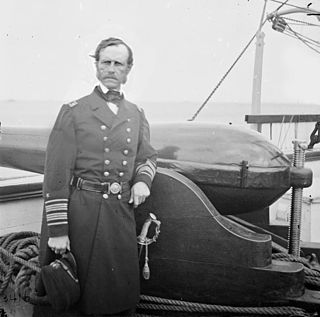 W
WDahlgren guns were muzzle-loading naval artillery designed by Rear Admiral John A. Dahlgren USN, mostly used in the period of the American Civil War. Dahlgren's design philosophy evolved from an accidental explosion in 1849 of a 32 lb (14.5 kg) gun being tested for accuracy, killing a gunner. He believed a safer, more powerful naval cannon could be designed using more scientific design criteria. Dahlgren guns were designed with a smooth curved shape, equalizing strain and concentrating more weight of metal in the gun breech where the greatest pressure of expanding propellant gases needed to be met to keep the gun from bursting. Because of their rounded contours, Dahlgren guns were nicknamed "soda bottles", a shape which became their most identifiable characteristic.
 W
WField artillery in the American Civil War refers to the artillery weapons, equipment, and practices used by the Artillery branch to support the infantry and cavalry forces in the field. It does not include siege artillery, use of artillery in fixed fortifications, or coastal or naval artillery. Nor does it include smaller, specialized artillery classified as small arms.
 W
WJames rifle is a generic term to describe any artillery gun rifled to the James pattern for use in the American Civil War, as used in some period documentation. Charles T. James developed a rifled projectile and rifling system. Modern authorities such as Warren Ripley and James Hazlett have suggested that the term "James rifle" only properly applies to 3.8 in (97 mm) bore field artillery pieces rifled to fire James' projectiles. They contend that the term does not apply to smoothbores that were later rifled to take the James projectiles in 3.67 in (93 mm) caliber or other calibers, and that those should instead be referred to as "Rifled 6 pounder", etc.
 W
WThe La Hitte system, named after the French general Ducos, Count de La Hitte, was an artillery system designed in March 1858 to implement rifled muzzle-loading guns in the French Army.
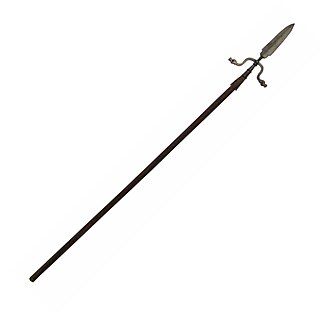 W
WA linstock is a staff with a fork at one end to hold a lighted slow match. The name was adapted from the Dutch lontstok, "match stick". Linstocks were used for discharging cannons in the early days of artillery; the linstock allowed the gunner to stand farther from the cannon as it was dangerous applying the lighted match to the touch hole at the breech of the gun: not only could the charge flash back, but the recoil of the cannon might send the carriage toward the gunner.
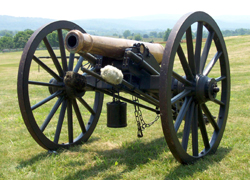 W
WThe M1841 6-pounder field gun was a bronze smoothbore muzzle-loading cannon that was adopted by the United States Army in 1841 and used from the Mexican–American War to the American Civil War. It fired a 6.1 lb (2.8 kg) round shot up to a distance of 1,523 yd (1,393 m) at 5° elevation. It could also fire canister shot and spherical case shot. The cannon proved very effective when employed by light artillery units during the Mexican–American War. The cannon was used during the early years of the American Civil War, but it was soon outclassed by newer field guns such as the 12-pounder Napoleon. In the US Army, the 6-pounders were replaced as soon as more modern weapons became available and none were manufactured after 1862. However, the Confederate States Army continued to use the cannon for a longer period because the lesser industrial capacity of the South could not produce newer guns as fast as the North.
 W
WThe M1841 12-pounder howitzer was a bronze smoothbore muzzle-loading artillery piece that was adopted by the United States Army in 1841 and employed from the Mexican–American War to the American Civil War. It fired a 8.9 lb (4.0 kg) shell up to a distance of 1,072 yd (980 m) at 5° elevation. It could also fire canister shot and spherical case shot. The howitzer proved effective when employed by light artillery units during the Mexican–American War. The howitzer was used throughout the American Civil War, but it was outclassed by the 12-pounder Napoleon which combined the functions of both field gun and howitzer. In the US Army, the 12-pounder howitzers were replaced as soon as more modern weapons became available. Though none were manufactured after 1862, the weapon was not officially discarded by the US Army until 1868. The Confederate States of America also manufactured and employed the howitzer during the American Civil War. The Confederate armies used the outmoded howitzer for a longer period.
 W
WThe M1841 24-pounder howitzer was a bronze smoothbore muzzle-loading artillery piece adopted by the United States Army in 1841 and employed from the Mexican–American War through the American Civil War. It fired a 18.4 lb (8.3 kg) shell to a distance of 1,322 yd (1,209 m) at 5° elevation. It could also fire canister shot and spherical case shot. The howitzer was designed to be employed in a mixed battery with 12-pounder field guns. By the time of the American Civil War, the 24-pounder howitzer was superseded by the 12-pounder Napoleon, which combined the functions of both field gun and howitzer. The 24-pounder howitzer's use as field artillery was limited during the conflict and production of the weapon in the North ended in 1863. The Confederate States of America manufactured a few 24-pounder howitzers and imported others from the Austrian Empire.
 W
WThe M1841 mountain howitzer was a mountain gun used by the United States Army during the mid-nineteenth century, from 1837 to about 1870. It saw service during the Mexican–American War of 1847–1848, the American Indian Wars, and during the American Civil War, 1861–1865.
 W
WThe Paixhans gun was the first naval gun designed to fire explosive shells. It was developed by the French general Henri-Joseph Paixhans in 1822–1823. The design furthered the evolution of naval artillery into the modern age. Its use presaged the end of wood as the preferred material in naval warships, and the rise of the ironclad.
 W
WThe Parrott rifle was a type of muzzle-loading rifled artillery weapon used extensively in the American Civil War.
 W
WA Quaker gun is a deception tactic that was commonly used in warfare during the 18th and 19th centuries. Although resembling an actual cannon, the Quaker gun was simply a wooden log, usually painted black, used to deceive an enemy. Misleading the enemy as to the strength of an emplacement was an effective delaying tactic. The name derives from the Religious Society of Friends or "Quakers", who have traditionally held a religious opposition to war and violence in the Peace Testimony.
 W
WThe Rodman gun is any of a series of American Civil War–era columbiads designed by Union artilleryman Thomas Jackson Rodman (1815–1871). The guns were designed to fire both shot and shell. These heavy guns were intended to be mounted in seacoast fortifications. They were built in 8-inch, 10-inch, 13-inch, 15-inch, and 20-inch bore. Other than size, the guns were all nearly identical in design, with a curving bottle shape, large flat cascabels with ratchets or sockets for the elevating mechanism. Rodman guns were true guns that did not have a howitzer-like powder chamber, as did many earlier columbiads. Rodman guns differed from all previous artillery because they were hollow cast, a new technology that Rodman developed that resulted in cast-iron guns that were much stronger than their predecessors.
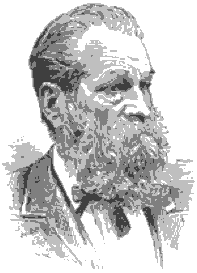 W
WSylvanus Sawyer was a United States inventor.
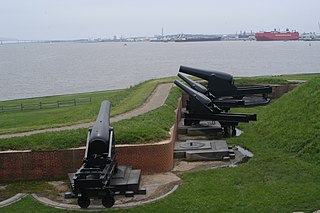 W
WSeacoast defense was a major concern for the United States from its independence until World War II. Before airplanes, many of America's enemies could only reach it from the sea, making coastal forts an economical alternative to standing armies or a large navy. After the 1940s, it was recognized that fixed fortifications were obsolete and ineffective against aircraft and missiles. However, in prior eras foreign fleets were a realistic threat, and substantial fortifications were built at key locations, especially protecting major harbors.
 W
WSiege artillery is heavy artillery primarily used in military attacks on fortified positions. At the time of the American Civil War, the U.S. Army classified its artillery into three types, depending on the gun's weight and intended use. Field artillery were light pieces that often traveled with the armies. Siege and garrison artillery were heavy pieces that could be used either in attacking or defending fortified places. Seacoast artillery were the heaviest pieces and were intended to be used in permanent fortifications along the seaboard. They were primarily designed to fire on attacking warships. The distinctions are somewhat arbitrary, as field, siege and garrison, and seacoast artillery were all used in various attacks and defenses of fortifications. This article will focus on the use of heavy artillery in the attack of fortified places during the American Civil War.
 W
WA traveling forge, when combined with a limber, comprised wagons specifically designed and constructed as blacksmith shops on wheels to carry the essential equipment necessary for blacksmiths, artisans and farriers to both shoe horses and repair wagons and artillery equipment for both U.S. and Confederate armies during the American Civil War, as well as by western European armies. The traveling forge was frequently also referred to in The Official Records simply as a forge, and sometimes referred to by Civil War buffs as a battery forge.
 W
WThe twelve-pound cannon is a cannon that fires twelve-pound projectiles from its barrel, as well as grapeshot, chain shot, shrapnel, and later shells and canister shot. It was first used during the Tudor period and was commonly used during the Napoleonic Wars, 1799–1815. At this time 12-pounders were the largest caliber of long-barreled field pieces, and were used both at long range against fortifications and troop concentrations using round shot and against attacking infantry and cavalry using canister shot. As such the 12-pounder was a favorite weapon of the Grande Armée. Later, redesigned 12-pounders were named after Napoleon III and found heavy use during the American Civil War.
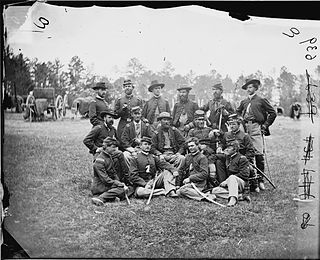 W
WThe Horse Artillery Brigade of the Army of the Potomac was a brigade of various batteries of horse artillery during the American Civil War.
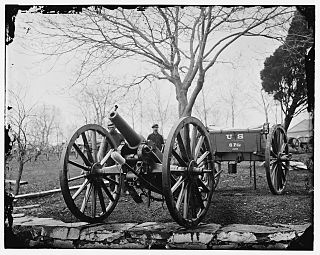 W
WThe Wiard rifle refers to several weapons invented by Norman Wiard, most commonly a semi-steel light artillery piece in six-pounder and twelve-pounder calibers. About 60 were manufactured between 1861 and 1862 during the American Civil War, at O'Donnell's Foundry, New York City: "although apparently excellent weapons, [they] do not seem to have been very popular". Wiard also designed a rifled steel version of the Dahlgren boat howitzer, among other gun types. Further, Wiard unsuccessfully attempted to develop a 15 in (381 mm) rifled gun for the US Navy and proposed a 20 in (510 mm) gun. In 1881 he unsuccessfully proposed various "combined rifle and smoothbore" weapon conversions of Rodman guns and Parrott rifles.